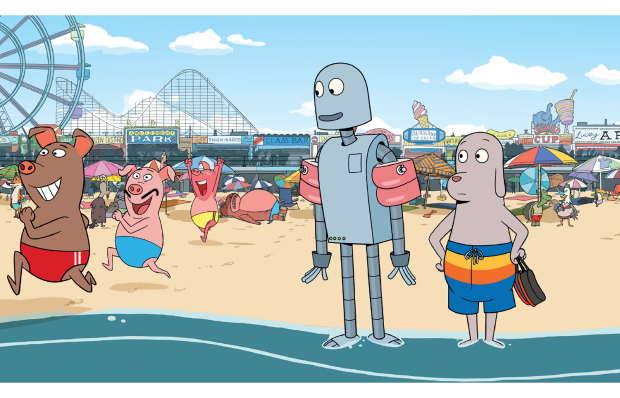The latest film from Wes Anderson is a doggy animation set in a fantasy Japan and as there was a screening in London earlier this week for owners and their dogs I took my own dog, Monty. He said he liked it. It was ‘good’, he said. I did not especially trust his opinion so investigated further. As good as, say, drinking from the toilet? ‘No,’ he said, ‘not as good as that, obvs.’ As good as this tennis ball here? ‘No’, he said, ‘because a tennis ball is always AMAZING!’ As good as cheese? ‘Nothing is as good as cheese. Fair play, you caught me out there.’ You didn’t find, I continued, that while the animation was compelling the story was not, and as with so much of Wes Anderson’s work (Fantastic Mr Fox, Grand Budapest Hotel) it offers a feast for the eyes but little for the heart? And didn’t you sleep through most of it anyhow? ‘But I woke up to slurp my genitals! At least twice!’ he protested. And I had to give him that. Still, I think you can see why no dog has yet to be offered a column in Sight & Sound, even though it would likely make the magazine a livelier read.
Isle of Dogs is visually exquisite, truly. Anderson has used stop-motion animation and the detail is phenomenal. The dogs are wonderfully rendered. You can see every pore on every nose and every strand of fur and every flea scuttling through that fur. In fact, everything is wonderfully rendered, including the hot drinks with steam rising, created by tiny wisps of cotton wool. Every frame is packed to the hilt, so in this respect you could look at it for ever and to hell with slurping your genitals. (I didn’t slurp them once.) But the narrative, which is told in a most fractured, non-linear way, via flashbacks to here, there and everywhere, is so diffuse that it’s hard to know what matters, and it’s even harder to care.
The film is set two decades hence in a fictional Japanese city and our antagonist is an evil Mayor (voiced by Kunichi Nomura) who hates dogs and uses an outbreak of ‘snout fever’ as an excuse to deport them to a rubbish dump, Trash Island, where they will be left to die. The main dogs on Trash Island are Spots (Liev Schreiber), Boss (Bill Murray), Rex (Edward Norton), King (Bob Balaban), Duke (Jeff Goldblum) and Chief (Bryan Cranston).
This would not pass any canine Bechdel test as the two lady dogs that turn up — Nutmeg (Scarlett Johansson) and Peppermint (Kara Hayward) — don’t contribute to the action and are small and slinky and dainty and domestic. The gender divide not only seems disappointing, but also made me question whether Anderson actually knows dogs, given that Monty’s best friend is a German shepherd called Lulu who rough-houses like a tank. (‘I love her, but she’s not feminine,’ he will concede.) I’ve since read that Anderson has little interest in dogs but does own a pygmy goat, and all I’m saying is that this shows.
Meanwhile, as we go here, there and everywhere, other characters become involved. There’s Atari (Koyu Rankin), the Mayor’s 12-year-old (and rather charmless) ward who comes looking for Spot, as Spot used to be his dog. Back in the city there’s a scientist (Ken Watanabe) who has invented a dog-flu serum and there’s also a high school foreign-exchange student, Tracy (Greta Gerwig), who rallies protestors and is determined to bring the Mayor down. Tracy is white and American and wears an itsy-bitsy skirt. Why white and American and not Japanese? Is a ‘white saviour’ entirely necessary here? Why the itsy-bitsy skirt? Only Anderson can adequately answer such questions, perhaps when he is not otherwise occupied with his goat.
The film, which Anderson intended as an homage to Japanese cinema, has been taken as ‘cultural appropriation’ in some quarters — the dogs speak English; the Japanese speak Japanese that is sometimes left untranslated, thereby ‘reducing the people of Megasaki to foreigners in their own city’ — while its themes have been much discussed. It’s about American politics, say some. It’s about anti-immigrant feeling and holocausts generally, say others. But the main thing to know is that none of it works to the extent that you give any kind of a damn. It’s so highly stylised that it all happens at a chilly remove, and we’re not given reason to feel anything. It’s like an extended episode of Scooby-Doo, albeit the most beautiful episode you will ever see, which is good but not as good as chasing a squirrel up a tree. ‘That’s MY FAVOURITE! WHERE IS IT? WHERE???’
Got something to add? Join the discussion and comment below.
Get 10 issues for just $10
Subscribe to The Spectator Australia today for the next 10 magazine issues, plus full online access, for just $10.
You might disagree with half of it, but you’ll enjoy reading all of it. Try your first month for free, then just $2 a week for the remainder of your first year.














Comments
Don't miss out
Join the conversation with other Spectator Australia readers. Subscribe to leave a comment.
SUBSCRIBEAlready a subscriber? Log in